EXAMINATION
| TECHNIQUE | FINDINGS |
|---|---|
| FEMALES | |
| With patient seated and arms hanging loosely, inspect both breasts | |
| Inspect all quadrants and tail of Spence as shown in figure. If necessary, lift breasts with fingertips to expose lower and lateral aspects. | |
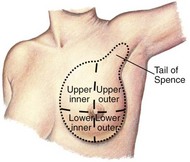 | |
 Size/shape/symmetry Size/shape/symmetry | EXPECTED:Convex, pendulous, or conical. Frequently asymmetric in size. |
 Texture/contour Texture/contour | EXPECTED:Smooth and uninterrupted. |
| UNEXPECTED:Dimpling or peau d’orange appearance. Changes or asymmetric appearance. | |
 Skin color Skin color | EXPECTED:Consistent color |
| UNEXPECTED:Areas of discoloration or asymmetric appearance. | |
 Venous patterns Venous patterns | EXPECTED:Bilateral venous networks, although pronounced generally only in pregnant or obese women. |
| UNEXPECTED:Unilateral network. | |
 Markings Markings | EXPECTED:Long-standing nevi. Supernumerary nipples possible (but could be a clue to other congenital abnormalities). |
| UNEXPECTED:Changing or tender nevi. Lesions. | |
| Inspect areolae and nipples | |
 Size/shape/symmetry Size/shape/symmetry | EXPECTED:Areolae round or oval, bilaterally equal or nearly equal. Nipples bilaterally equal or nearly equal in size and usually everted, although one or both sometimes inverted. |
| UNEXPECTED:Recent unilateral nipple inversion or retraction. | |
 Color Color | EXPECTED:Areolae and nipples pink to brown. |
| UNEXPECTED:Nonhomogeneous in color. | |
 Texture/contour Texture/contour | EXPECTED:Areolae smooth, except for Montgomery tubercles. Nipples smooth or wrinkled. |
| UNEXPECTED:Areolae with suppurative or tender Montgomery tubercles or with peau d’orange appearance. Nipples crusting, cracking, or with discharge. | |
| With patient in the following positions, reinspect both breasts | |
 Arms extended over head, or flexed behind the neck Arms extended over head, or flexed behind the neck | EXPECTED: All positions breasts bilaterally symmetric with even contour. |
| UNEXPECTED:Dimpling, retraction, deviation, or fixation of breasts. | |
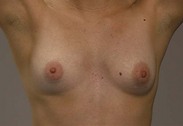 | |
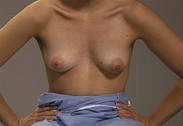 | |
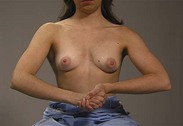 | |
 | |
| With patient seated and arms hanging loosely, palpate breasts | |
| Chest wall sweep.Place the palm of your right hand at the patient’s right clavicle at the sternum. Sweep downward from the clavicle to the nipple, feeling | EXPECTED:Tissue smooth, free of lumps. |
| UNEXPECTED:Lumps or nodules. Reassess with additional palpation and | |
| for superficial lumps. Repeat the sweep until you have covered the entire right chest wall. Repeat the procedure using your left hand for the left chest wall. | characterize any masses by location, size, shape, consistency, tenderness, mobility, delineation of borders, retraction. Use transillumination to assess presence of fluid in masses. |
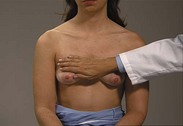 | |
Bimanual digital palpation.Place one hand, palmar surface facing up, under the patient’s right breast. Position your hand so that it acts as a flat surface against which to compress the breast tissue. Walk the fingers of the other hand across the breast tissue, feeling for lumps as you compress the tissue between your fingers and your flat hand. Repeat the procedure for the other breast.
Stay updated, free articles. Join our Telegram channel
Full access? Get Clinical Tree
 Get Clinical Tree app for offline access
Get Clinical Tree app for offline access

| |





